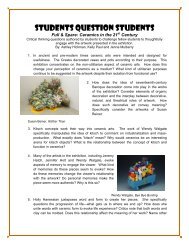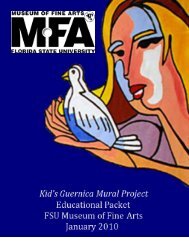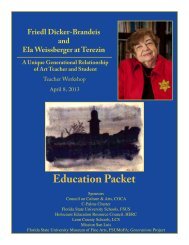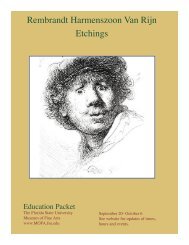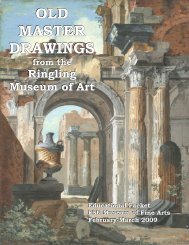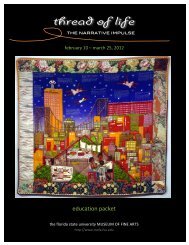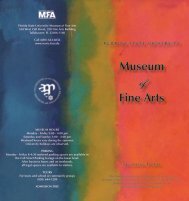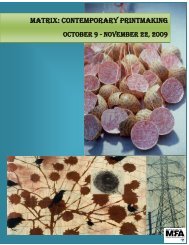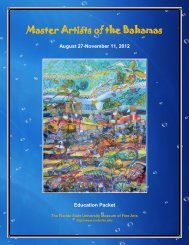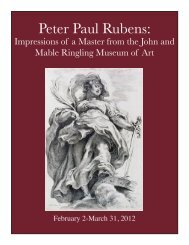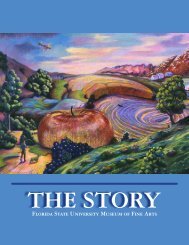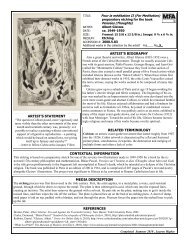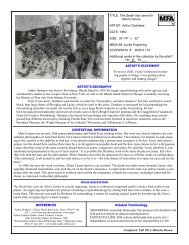Maximalist Painting - Museum of Fine Arts - Florida State University
Maximalist Painting - Museum of Fine Arts - Florida State University
Maximalist Painting - Museum of Fine Arts - Florida State University
Create successful ePaper yourself
Turn your PDF publications into a flip-book with our unique Google optimized e-Paper software.
<strong>Maximalist</strong> <strong>Painting</strong>:<br />
“More is More”<br />
The <strong>Florida</strong> <strong>State</strong> <strong>University</strong><br />
<strong>Museum</strong> <strong>of</strong> <strong>Fine</strong> <strong>Arts</strong><br />
February 16, 2007 - March 25, 2007
Table <strong>of</strong> Contents<br />
Letter to the Educators 1<br />
Sunshine <strong>State</strong> Standards 2<br />
Essays 3<br />
What is <strong>Maximalist</strong> <strong>Painting</strong>? 3-4<br />
A Reaction to Reductive Art. 5-6<br />
Artist Biographies 7<br />
Lilian Garcia Roig 7<br />
Dan Sutherland 8<br />
Peter Saul 9<br />
Masami Teraoka 10<br />
Interview with Lilian Garcia Roig 11-12<br />
Definitions <strong>of</strong> Terms 13<br />
Lesson Plans 14<br />
<strong>Maximalist</strong> <strong>Painting</strong> versus Minimalism 14-15<br />
Create a <strong>Maximalist</strong> Masterpiece 16<br />
Identifying <strong>Maximalist</strong> Characteristics 17- 19<br />
Extra Lesson Plans and Activities 20-21<br />
Image Index 22<br />
Bibliography 23<br />
Evaluation Sheet 24<br />
CD <strong>of</strong> Images (attached to back cover)<br />
Authored by: Rachel Thornton<br />
Edited By: Rachel Thornton and Viki D. Thompson Wylder<br />
Graphic Design by: Rachel Thornton and Loren Story<br />
Contributions by: Kristi Malone (“Identifying <strong>Maximalist</strong> Characteristics” and “Extra Lesson Plans and Activities”)<br />
For exhibition tours please contact Viki D. Wylder Thompson at 644-1299<br />
Cover: Julie Heffernan, Self-portrait As a Gorgeous Tumor 2.<br />
*Images for educational use only.
Leon county Educators,<br />
Letter to the Educators<br />
In Spring 2007 the <strong>Museum</strong> <strong>of</strong> <strong>Fine</strong> <strong>Arts</strong> at the <strong>Florida</strong> <strong>State</strong><br />
<strong>University</strong> will be holding an exhibition on <strong>Maximalist</strong> painting. The<br />
exhibition will present paintings that exemplify the latest in twenty-first<br />
century art. The artists <strong>of</strong> these works demonstrate a common style<br />
<strong>of</strong> painting that is fresh, visual and imaginative. This style refers to the<br />
visual overload that is <strong>Maximalist</strong> painting. Tours and activities are<br />
being <strong>of</strong>fered with the exhibition.<br />
This packet is sent to the educators <strong>of</strong> Leon County to promote<br />
the <strong>Maximalist</strong> painting exhibition. The packet includes an<br />
explanation <strong>of</strong> what <strong>Maximalist</strong> painting is and how it fits into art<br />
history. This packet also includes lesson plans that can be done at<br />
the exhibition or in the classroom. The lesson plans are in<br />
accordance with the <strong>Florida</strong> Sunshine <strong>State</strong> Standards and<br />
incorporate art education, art history, art production, and aesthetics.<br />
Rachel Thornton<br />
<strong>Museum</strong> Education Program<br />
<strong>Florida</strong> <strong>State</strong> <strong>University</strong> <strong>Museum</strong> <strong>of</strong> <strong>Fine</strong> <strong>Arts</strong><br />
1
Sunshine <strong>State</strong> Standards:<br />
Sunshine <strong>State</strong> Standards<br />
The Sunshine <strong>State</strong> Standards are effective for all grade levels.<br />
The <strong>Arts</strong><br />
Skills and Techniques:<br />
Standard 1: The student understands and applies media,<br />
techniques, and processes.<br />
Creation and Communication:<br />
Standard 1: The student creates and communicates a range <strong>of</strong><br />
subject matter, symbols, and ideas using knowledge or structures<br />
and functions <strong>of</strong> visual arts.<br />
Cultural and Historical Connections:<br />
Standard 1: The student understands the visual arts in relation to<br />
history and culture.<br />
Aesthetic and Critical Analysis:<br />
Standard 1: The student asses, evaluates, and responds to the<br />
characteristics <strong>of</strong> works <strong>of</strong> art.<br />
Language <strong>Arts</strong><br />
Listening, Viewing, and Speaking:<br />
Standard 1: The student uses listening strategies effectively.<br />
Standard 2: The student uses viewing strategies effectively.<br />
Standard 3: The student uses speaking strategies effectively.<br />
Writing:<br />
Standard 1: The student uses writing processes effectively.<br />
Standard 2: The student writes to communicate ideas and<br />
information.<br />
2
What is <strong>Maximalist</strong> <strong>Painting</strong>?<br />
Essays<br />
<strong>Maximalist</strong> painting is an experimental painting style practiced<br />
by a number <strong>of</strong> today’s artists. This style has been an area <strong>of</strong><br />
exploration since about the year 2000. It<br />
is not possible to describe <strong>Maximalist</strong><br />
painting as a distinct movement. Instead,<br />
it should only be considered as a general<br />
style. Within the general <strong>Maximalist</strong><br />
painting style are two sub-styles: vertical<br />
layering and horizontal layering.<br />
The goal <strong>of</strong> <strong>Maximalist</strong> painting is<br />
to create a complex experience. The<br />
subjects <strong>of</strong> <strong>Maximalist</strong> painting are also<br />
important, <strong>of</strong>ten referencing social ideals.<br />
<strong>Maximalist</strong> painting requires the viewer to be actively involved in the<br />
viewing <strong>of</strong> the art.<br />
<strong>Maximalist</strong> painting is hard to define. However, it can best be<br />
discussed in two ways. First, <strong>Maximalist</strong> painting is visually dense in<br />
composition. The canvas appears to be packed with multiple<br />
narratives or stories. This can be referred to as horizontal layering.<br />
Thus horizontal layering is seen as the expression <strong>of</strong> multiple<br />
narratives in a piece <strong>of</strong> art. The artist, Julie Heffernan, uses horizontal<br />
layering in her painting. In her work, Self Portrait as Several Tiny<br />
Gods, the artist, at first glance, appears to present a still life, a vase<br />
<strong>of</strong> flowers. However, when the viewer<br />
takes a closer look, a million details,<br />
scenes and people, appear in the petals<br />
<strong>of</strong> the flowers.<br />
Secondly, <strong>Maximalist</strong> painting may<br />
emphasize technique. Technique refers<br />
to the type <strong>of</strong> brush stroke used, the<br />
style chosen, and the type <strong>of</strong> paint used<br />
in rendering the image. The technique is<br />
<strong>of</strong>ten layered, skilled and imaginative.<br />
The heavy, technical layering in a piece<br />
Julie Heffernan, Self Portrait as<br />
Several Tiny Gods.<br />
Dan Sutherland, Plastic Martyrdumb<br />
Head On with a Career Teeth<br />
Propagator<br />
is referred to as vertical layering. This<br />
emphasis on technique instead <strong>of</strong><br />
narrative usually makes the work more<br />
conceptual. Dan Sutherland is an example <strong>of</strong> a <strong>Maximalist</strong> painter<br />
3
Essays<br />
who explores technique. In his painting, Plastic Martyrdumb Head on<br />
with a Career Teeth Propagator, Sutherland <strong>of</strong>fers both figurative and<br />
abstract forms, overwhelming the canvas in a flat and perspectivless<br />
style.<br />
The typical subject <strong>of</strong> a <strong>Maximalist</strong> painting addresses social<br />
conditions in today’s world. The subject is usually a direct response to<br />
the relationship between nature and culture. The viewer can observe<br />
the tie between the human condition, social aspirations, and society’s<br />
effect on the world. An example <strong>of</strong> this is Kehinde Wiley’s painting<br />
Passing/Posing Assumption. Wiley is a young “up and coming” artist.<br />
His paintings are masterful in technique and his subject is always a<br />
young black male. He finds his models on the street, shows them his<br />
work, and asks them to pick paintings from<br />
a book <strong>of</strong> old master work. He then<br />
appropriates the image, but changes the<br />
subjects to address issues in hip/hop<br />
culture.<br />
<strong>Maximalist</strong> painting is not always an<br />
overload <strong>of</strong> stuff on the canvas but it should<br />
always create a sense <strong>of</strong> complexity.<br />
Whether narrative or conceptual in design,<br />
<strong>Maximalist</strong> painting should involve a<br />
complex image to create a complex<br />
experience that results in a complex<br />
response to the painting. This means that<br />
the picture plane <strong>of</strong> the painting itself is<br />
complex but doesn’t necessarily need a<br />
Kehinde Wiley, Pasing/Posing<br />
(Assumption)<br />
complex analysis to explain it. According to painter Lilian Garcia Roig,<br />
a painting that is considered <strong>Maximalist</strong> should speak a thousand<br />
words instead <strong>of</strong> needing a thousand word explanation.<br />
Though <strong>Maximalist</strong> painting is hard to explain, it is easily<br />
recognized when it is seen, a primary goal <strong>of</strong> the style. <strong>Maximalist</strong><br />
painting has many layers, verging on visual overload in the form <strong>of</strong><br />
narrative or technique as seen in the examples <strong>of</strong> the work <strong>of</strong> Julie<br />
Heffernan, Dan Sutherland, or Kehinde Wiley. <strong>Maximalist</strong> painting<br />
is consistent in its subject matter, which deals with the human<br />
condition and <strong>of</strong>ten links human life to nature. Finally <strong>Maximalist</strong><br />
painting creates an environment in which the viewer may lose him<br />
or herself. <strong>Maximalist</strong> painting is a unique style that analyzes itself<br />
without the help <strong>of</strong> critical scrutiny.<br />
4
A Reaction to Reductive Art<br />
Essays<br />
Throughout the twentieth century, many artists focused on the<br />
reduction <strong>of</strong> form to reach a sense <strong>of</strong> purity through medium.<br />
Examples <strong>of</strong> this reduction were seen in the Minimalist movement as<br />
well as work produced by the German Bauhaus aesthetic. Both<br />
philosophies, Minimalist and Bauhaus, used a “less is more”<br />
approach. <strong>Maximalist</strong> painting doesn’t disagree with what these two<br />
movements tried to achieve. It just asks the adverse question, “Why<br />
can’t more be more (Garcia Roig)?” <strong>Maximalist</strong> painting <strong>of</strong>fers work<br />
in diametric opposition to these previous movements that produced<br />
austere art forms.<br />
However, to understand the<br />
origins <strong>of</strong> <strong>Maximalist</strong> painting, one<br />
must first understand its<br />
predecessors. The history <strong>of</strong> art is a<br />
history <strong>of</strong> evolution or change over<br />
time. During the twentieth century,<br />
a strand <strong>of</strong> thinking fostered the<br />
simplification <strong>of</strong> art. The best<br />
example <strong>of</strong> this was the<br />
aforementioned Minimalism, a genre<br />
that tended to focus on sculpture and primary geometric shapes. For<br />
example, Tony Smith’s Die was literally a large black cube.<br />
Minimalism, as a style, “lack[ed] identifiable subjects, colors, surface<br />
textures, and narrative elements.” (Gardner, 1082). The goal <strong>of</strong><br />
Minimalism was to “prevent viewers from<br />
drawing on assumptions or preconceptions”<br />
while viewing art (1083). Minimalism’s<br />
reductive qualities made it meditative and<br />
relaxing. The viewer wasn’t “bamboozled”<br />
by an array <strong>of</strong> images through which to sort.<br />
Minimalism, like the Bauhaus, created a<br />
metamorphic straight line to connect point A<br />
to point B instead <strong>of</strong> <strong>of</strong>fering a long<br />
confusing maze.<br />
Josef Albers, Homage to the<br />
Square<br />
Tony Smith, Die<br />
An important goal for the German<br />
Bauhaus, a school <strong>of</strong> art in the early<br />
5
6<br />
Essays<br />
twentieth century, was to link art with craft. Thus Bauhaus workshops<br />
created everything: furniture, architecture, paintings and sculpture. As<br />
with Minimalism, the Bauhaus espoused a “less is more” philosophy.<br />
The art that came out <strong>of</strong> the Bauhaus felt solid, making use <strong>of</strong> straight<br />
lines and patternless materials. For example the painting by Josef<br />
Albers, Homage to the Square, was indicative <strong>of</strong> Bauhaus work. This<br />
painting used a streamlined composition and restricted color. The<br />
entire work was painted in red and orange. Albers’ painting was<br />
minimal and bare. It fit into the Bauhaus “less is more” philosophy.<br />
Now with the inception <strong>of</strong> the twenty-first century, artists <strong>of</strong>ten<br />
expect “more” in the work they produce. Many returned to narrative<br />
and a more painterly style with visual effects. An example <strong>of</strong> this can<br />
be seen in Trenton Doyle Hancock’s painting, Painter and Loid<br />
Struggle. This image features a narrative with mythological creatures<br />
the artist incorporates in all <strong>of</strong> his<br />
paintings. The story he tries to<br />
convey is enticing.<br />
<strong>Maximalist</strong> painting, a twentyfirst<br />
century style, is a reaction to<br />
reductive art. The <strong>Maximalist</strong><br />
philosophy is “more is more.” Works<br />
from both Minimalist and the<br />
Bauhaus schools <strong>of</strong> thinking were<br />
simplistic and visually unstimulating.<br />
<strong>Maximalist</strong> painting instead seeks to<br />
become a source <strong>of</strong> visual<br />
stimulation, an explosion for the<br />
senses. Maximalism is<br />
Trenton Doyle Hancock, Painter and Loid<br />
Struggle<br />
confrontational and direct. It is not meant to be meditative, but an<br />
exciting, experience. <strong>Maximalist</strong> painting does not discount the<br />
philosophy <strong>of</strong> the artistic style that preceded it but states that “less is<br />
more” is not the only philosophy <strong>of</strong> art. Thus the twenty-first century<br />
brings a new concept. <strong>Maximalist</strong> painting overwhelms the viewer<br />
with an overload <strong>of</strong> images instead <strong>of</strong> taking everything visual out <strong>of</strong><br />
the art.
Lilian Garcia Roig<br />
Artist Biographies<br />
Lilian Garcia Roig is a painter <strong>of</strong> dense landscapes. Her<br />
compositions can be overwhelming. Garcia Roig’s landscapes are<br />
plein-air based, which means she paints them outdoors in the<br />
environments in which the original scenes exist.<br />
According to Garcia Roig, she is trying to “capture the character<br />
<strong>of</strong> seemingly ordinary, dense landscapes in a way that reflects a<br />
passionate engagement with the scene and with the painting<br />
process.” With that being said, Garcia<br />
Roig is trying to show the viewer the<br />
passion the artist feels while painting.<br />
She tries to capture the emotion in the<br />
painting. <strong>Painting</strong> in the environment<br />
better allows her to do so.<br />
Garcia Roig’s goal is to make<br />
the viewer feel as though they are in<br />
the midst <strong>of</strong> the landscape. An<br />
example <strong>of</strong> this can be seen in her<br />
painting Lone Alderwood. This<br />
Lilian Garcia Roig, Lone Alderwood<br />
Lilian Garcia Roig, Lone Alderwood<br />
painting depicts the dense and<br />
tangled woods <strong>of</strong> North <strong>Florida</strong>. She<br />
feels the painting should mentally and<br />
physically take over viewers in a way<br />
that puts them, or surrounds them, in<br />
the location.<br />
Garcia Roig paints trees, leaves,<br />
and branches that seem to strive to break out <strong>of</strong> the picture plane <strong>of</strong><br />
the canvas. The heavy amount <strong>of</strong> paint Garcia Roig uses adds to this<br />
effect. Her paintings have valleys and mountains <strong>of</strong> paint giving them<br />
a three-dimensional quality. Garcia Roig will sometimes squeeze<br />
paint directly from the tube onto the canvas. By doing this, the paint<br />
itself is invading the viewer’s space just as the leaves <strong>of</strong> a tree might<br />
if one were to walk through a forest.<br />
Garcia Roig is currently a pr<strong>of</strong>essor <strong>of</strong> painting at the <strong>Florida</strong><br />
<strong>State</strong> <strong>University</strong>.<br />
7
8<br />
Dan Sutherland:<br />
Artist Biographies<br />
Dan Sutherland began his painting career by composing picture<br />
planes full <strong>of</strong> unfamiliar, unrecognizable, and abstract objects.<br />
Though the objects in his paintings appeared to be mere images <strong>of</strong><br />
the unknown, he was really depicting elaborate objects such as<br />
jewelry, furniture and lavish costumes. These items were important<br />
subjects <strong>of</strong> Sutherland’s paintings because he wanted to represent<br />
the everyday<br />
decadence to which<br />
society has become<br />
accustomed.<br />
In more recent<br />
paintings, Sutherland<br />
has begun painting<br />
flower arrangements in<br />
an abstract manner. In<br />
his still lifes, Sutherland<br />
hopes to confront<br />
viewers with beautiful<br />
pictorial objects, a<br />
means to urging the<br />
audience to take a<br />
closer look. The color<br />
palette <strong>of</strong> Sutherland’s<br />
Dan Sutherland, Pank Scabrous<br />
paintings consists <strong>of</strong> warm reds, yellows and oranges that are<br />
attractive to the viewer. The viewer should see then “a conflict<br />
between human control/consciences and natural chaos.” Sutherland<br />
feels the flower arrangements achieve this goal because they are<br />
beautiful but naturally complex.<br />
An example <strong>of</strong> this is Sutherland’s Pank Scabrous. This<br />
painting shows an abstract floral arrangement surrounded by<br />
geometric shapes. The painting is asymmetrical to say the least. The<br />
balance appears to be askew. However, warm colors <strong>of</strong> the painting<br />
blend together to create an inviting environment.<br />
Sutherland is currently a pr<strong>of</strong>essor <strong>of</strong> painting at the <strong>University</strong><br />
<strong>of</strong> Texas at Austin.
Peter Saul:<br />
Artist Biographies<br />
Peter Saul is known as a non-conformist artist. He does not<br />
always paint subjects that people want or expect to see. Saul’s<br />
paintings are intertwined with beauty, savagery, romance and<br />
ugliness.<br />
The beauty <strong>of</strong> Saul’s paintings comes from the unrefined<br />
drapery <strong>of</strong> the lucid figures, which creates a flow the viewer can<br />
follow throughout the painting. The ugliness <strong>of</strong> Saul’s paintings is<br />
formed by the confrontational nature they possess. The paintings<br />
don’t hold back.<br />
An example <strong>of</strong> this<br />
is Saul’s Art Critic’s<br />
Suicide. This painting is<br />
violent and bloody in an<br />
antiseptic, pop art way.<br />
As the two figures<br />
commit suicide they look<br />
at the viewer directly in<br />
the eyes.<br />
The romance and<br />
savagery <strong>of</strong> Saul’s work<br />
combine to reveal ideas<br />
Peter Saul, Art Critics' Suicide<br />
about the harshness <strong>of</strong><br />
death, social criticism,<br />
self-absorption, or about having a lack <strong>of</strong> respect for others. All <strong>of</strong> this<br />
is expressed through Saul’s use <strong>of</strong> a bold and brash color palette.<br />
Saul combines abrasive colors, bold greens, blues, reds and yellows,<br />
with his views on the moral decadence in pop culture to represent the<br />
violence and vulgarity he sees in the world. All <strong>of</strong> the formal elements<br />
<strong>of</strong> Saul’s paintings are meant to “disarm the viewer” creating a way to<br />
make members <strong>of</strong> the audience sense their own vulnerability and to<br />
make them examine their own morals. Saul’s work is meant to be<br />
unapologetic.<br />
Peter Saul currently lives and works in <strong>Florida</strong>.<br />
9
10<br />
Masami Teraoka<br />
Artist Biographies<br />
Masami Teraoka is a narrative painter. A narrative painting<br />
follows a story line. Although Teraoka’s paintings should be viewed<br />
as realistic, they should not be viewed as reality, meaning that any<br />
given work may be inspired by a particular event but not necessarily<br />
show a naturalistic depiction <strong>of</strong> that event. Conversely the work may<br />
be painted in a visually realistic way but not emanate from reality. The<br />
subjects <strong>of</strong> Teraoka’s paintings confront political issues such as gay<br />
marriage, Catholic priest scandals, and international affairs.<br />
As Teraoka is a Japanese artist living and working in the United<br />
<strong>State</strong>s, he <strong>of</strong>ten<br />
paints in a<br />
manner that<br />
depicts his<br />
heritage and its<br />
involvement with<br />
Western<br />
expansion. An<br />
example <strong>of</strong> this is<br />
his painting<br />
McDonalds’<br />
Hamburgers<br />
Invading Japan.<br />
This painting Masami Teraoka, McDonald's Hamburgers Invading Japan<br />
illustrates two<br />
women in traditional Japanese costume, jewelry, and up-do, which<br />
signify them as Geishas. The wall behind the two women is<br />
decorated with calligraphy, which is a popular motif in Japanese art.<br />
The irony <strong>of</strong> the painting is that these very traditional Japanese<br />
women are eating McDonalds’ hamburgers.<br />
The goal <strong>of</strong> Teraoka’s paintings is to create a complex and<br />
controversial pictorial plane. He paints with oil paints to depict scenes<br />
he hopes will confront the viewer.
Interview with Lilian Garcia Roig<br />
Lilian Garcia Roig, Supporting Branches<br />
Artist Interview<br />
Lilian Garcia Roig is a pr<strong>of</strong>essor <strong>of</strong> painting at <strong>Florida</strong> <strong>State</strong><br />
<strong>University</strong>. Her paintings incorporate scenery from the north <strong>Florida</strong><br />
landscape.<br />
Rachel Thornton: Which painters seem to exemplify Maximalism<br />
more than others? Can you explain your choices?<br />
Lilian Garcia Roig: Julie Heffernan is a good example because her<br />
paintings are very dense. They have a Rococo, Post Modern and<br />
Baroque style that make them interesting. Dan Sutherland is another<br />
good example because he explores various techniques. Kehinde<br />
Wiley’s painting also exemplifies <strong>Maximalist</strong> painting because they<br />
are narrative, grossly realistic and they are very visually stimulating.<br />
RT: What is the philosophy <strong>of</strong> <strong>Maximalist</strong> painting?<br />
LGR: <strong>Maximalist</strong> painting tries to create a sense <strong>of</strong> more in art. In the<br />
past art was reduced in the “less is more” theory until an explanation<br />
was needed for understanding by the viewer. <strong>Maximalist</strong> painting<br />
doesn’t disagree with the “less is more” concept, but asks why more<br />
11
12<br />
Artist Interview<br />
can’t be more. <strong>Maximalist</strong> painting is hard to define. Sometimes it’s<br />
easier to say what it’s not as opposed to what it is. <strong>Maximalist</strong><br />
painting is not reductive. <strong>Maximalist</strong> painting should have multiple<br />
readings that are subversive. The onion analogy is a good way to<br />
describe it. One should be able to peel back layers <strong>of</strong> the painting: its<br />
balance, the compositional details, and the technique used to execute<br />
the painting.<br />
RT: From what did <strong>Maximalist</strong> painting root?<br />
LGR: <strong>Maximalist</strong> painting is a style that grew from, or reacted<br />
against, movements in the twentieth century that involved a “less is<br />
more” philosophy. The specific movements to which <strong>Maximalist</strong><br />
painting relates are Minimalism and the Bauhaus. Other movements<br />
or time periods important to <strong>Maximalist</strong> painting are the Baroque and<br />
Surrealism. These relate to what <strong>Maximalist</strong> painting is trying to do as<br />
a style.<br />
RT: What role, if any, does Minimalism play in <strong>Maximalist</strong> painting?<br />
LGR: <strong>Maximalist</strong> painting is visual versus the conceptual <strong>of</strong><br />
Minimalism or the Bauhaus. <strong>Maximalist</strong> painting is a visual overload<br />
that should be done in a very skilled and imaginative way.<br />
RT: What inspires you within the idea <strong>of</strong> <strong>Maximalist</strong> painting? What<br />
draws you to it?<br />
LGR: In my paintings I try to tie in my Cuban heritage. My mother<br />
plays a significant role in my painting. She could never understand<br />
why I might want a nice simple black linen dress as opposed to a<br />
colorful ruffled dress if they cost the same amount. Why wouldn’t you<br />
choose the dress with more? I apply this to my painting. I like to<br />
create paintings with a visual overload because if you can, then why<br />
wouldn’t you?<br />
*LGR: Lilian Garcia Roig. These comments are not to be taken literally but are drawn from notes<br />
taken during an interview.
Definitions <strong>of</strong> Terms<br />
Key Terms<br />
Abstract- In painting and sculpture, emphasizing a derived, essential<br />
character that has only a stylized or symbolic visual reference to<br />
objects in nature.<br />
Calligraphy- Handwriting or penmanship used as a decorative art.<br />
Composition- The way in which an artist organizes forms in an<br />
artwork, either by placing shapes on a flat surface or arranging forms<br />
in space.<br />
Conceptual- An American avant-garde art trend from the 1960s that<br />
asserted the “artfulness” <strong>of</strong> art lay in the artist’s idea, rather than the<br />
final expression.<br />
German Bauhaus- A school <strong>of</strong> architecture in Germany in the 1920s<br />
under the aegis <strong>of</strong> Walter Gropius, who emphasized the unity <strong>of</strong> art,<br />
architecture and design.<br />
Horizontal Layering- The expression <strong>of</strong> multiple narratives in a work.<br />
Medium- The substance or agency in which the artist works.<br />
Minimalism- An American predominantly sculptural trend <strong>of</strong> the<br />
1960s whose works consist <strong>of</strong> a severe reduction <strong>of</strong> form to single,<br />
homogeneous units called “primary structures.”<br />
Narrative- Elements in a work <strong>of</strong> art arranged in such a manner as to<br />
tell a story.<br />
Still Life- A picture depicting an arrangement <strong>of</strong> objects.<br />
Technique- The process that artists employ to create form, as well<br />
as the distinctive, personal ways they handle their materials and<br />
tools.<br />
Vertical Layering- An emphasis on technique instead <strong>of</strong> narrative in<br />
a work.<br />
13
<strong>Maximalist</strong> <strong>Painting</strong> versus Minimalism<br />
Lesson Plans<br />
Session Activity: The students will view several pieces <strong>of</strong> both <strong>Maximalist</strong> and<br />
Minimalist art to learn how to distinguish movements in art history, to see their<br />
similarities and differences.<br />
Levels: 6-12<br />
Time Needed: 45 min- 60 min.<br />
Objective: Students will learn how to compare and contrast different types <strong>of</strong> art<br />
and develop a better understanding for art history. They should learn how<br />
paintings <strong>of</strong> various categories when studied can sometimes be proven to be<br />
more alike or more different than they at first appear.<br />
Materials:<br />
- Paper and pencil or pen<br />
- A selection <strong>of</strong> images from both the Minimalist movement and <strong>Maximalist</strong><br />
painting<br />
- Pictures <strong>of</strong> <strong>Maximalist</strong> paintings and Minimalist art<br />
- One or two slide projectors<br />
Procedure:<br />
Discussion<br />
Explain to students what <strong>Maximalist</strong> painting and Minimalism is. Have them<br />
identify the following:<br />
• The definition <strong>of</strong> <strong>Maximalist</strong> painting and Minimalism.<br />
• The differences in the primary medium <strong>of</strong> the two styles.<br />
• Important artists who practiced <strong>Maximalist</strong> painting and Minimalism.<br />
• The effect both styles have on the psyche.<br />
• Technical executions <strong>of</strong> both styles.<br />
• The purpose <strong>of</strong> both <strong>Maximalist</strong> painting and Minimalism.<br />
• The use <strong>of</strong> color, line and imagery in <strong>Maximalist</strong> painting and Minimalism.<br />
Activity<br />
If a visit to the <strong>Maximalist</strong> painting exhibition is possible:<br />
1. Before going to the museum, prepare students by showing them examples <strong>of</strong><br />
<strong>Maximalist</strong> painting and Minimalist art.<br />
14
15<br />
Lesson Plans<br />
2. Once at the museum, pass out the attached worksheet and show students an<br />
example <strong>of</strong> <strong>Maximalist</strong> painting and begin a discussion about the work.<br />
3. Once students have viewed the <strong>Maximalist</strong> painting ask them how it relates to<br />
Minimalism. Show them a picture <strong>of</strong> a Minimalist work.<br />
4. Lead a discussion in comparing and contrasting a Minimalist work, such as<br />
Tony Smith’s Die, to a <strong>Maximalist</strong> painting.<br />
If a visit to the <strong>Maximalist</strong> painting exhibition is not possible:<br />
1. In the classroom, use a projector to project a piece <strong>of</strong> <strong>Maximalist</strong> painting such<br />
as Julie Heffernan’s Self-Portrait As Several Tiny Gods. Ask the students to<br />
describe what they see.<br />
2. Project a piece <strong>of</strong> Minimalist art, such as Frank Stella’s Six Mile Bottom. Ask<br />
the students to describe it.<br />
3. Show both the <strong>Maximalist</strong> painting and the Minimalist art via the projector and<br />
ask the students to discuss the differences, similarities and importance <strong>of</strong> both<br />
pieces.<br />
4. Provide the students with the attached worksheet and divide them into groups<br />
<strong>of</strong> three or four people. Have the students discuss the artwork and fill out the<br />
worksheet.<br />
Evaluation: Students should be able to recognize both Minimalism and<br />
<strong>Maximalist</strong> painting and how they relate to each other. Through the discussions<br />
and the worksheet observe that students know the following points:<br />
• The definition <strong>of</strong> <strong>Maximalist</strong> painting and Minimalism.<br />
• The differences in the primary medium <strong>of</strong> the two styles.<br />
• Important artists who practiced <strong>Maximalist</strong> painting and Minimalism.<br />
• The effect both styles have on the psyche.<br />
• Technical executions <strong>of</strong> both styles.<br />
• The purpose <strong>of</strong> both <strong>Maximalist</strong> painting and Minimalism.<br />
• The use <strong>of</strong> color, line and imagery in <strong>Maximalist</strong> painting and Minimalism.
Create a <strong>Maximalist</strong> Masterpiece<br />
Session Activity: The students will create their own <strong>Maximalist</strong> paintings.<br />
Levels: 6-12<br />
Time Needed: Make into several class sessions.<br />
Lesson Plans<br />
Objective: Students will develop a better understanding <strong>of</strong> vertical and horizontal<br />
layering. As they create their <strong>Maximalist</strong> paintings they should think about<br />
whether they want their paintings to be narrative or technical.<br />
Materials:<br />
- Paint<br />
- Paintbrushes<br />
- Canvas or paper<br />
Procedure:<br />
Discussion<br />
• Explain to the students what <strong>Maximalist</strong> painting is.<br />
• Help them understand the goals and ideas behind it.<br />
• Explain horizontal and vertical layering in detail.<br />
• Discuss the differences, similarities and importance <strong>of</strong> both vertical and<br />
horizontal layering.<br />
• Ask students to think about which style they like the best and why.<br />
Activity<br />
1. Ask students to make a painting that is an example <strong>of</strong> either vertical or<br />
horizontal layering.<br />
2. When finished, students should discuss their paintings with the class. They<br />
should explain their use <strong>of</strong> vertical or horizontal layering, why they liked one over<br />
the other, how their paintings relate to vertical and horizontal layering, and what<br />
makes their paintings <strong>Maximalist</strong> paintings.<br />
Evaluation: By viewing and discussing the paintings the students create, they<br />
will demonstrate an understanding <strong>of</strong> <strong>Maximalist</strong> painting and what goes into<br />
creating a <strong>Maximalist</strong> painting. They will display their knowledge <strong>of</strong> vertical and<br />
horizontal layering.<br />
16
Identifying <strong>Maximalist</strong> Characteristics<br />
Lesson Plans<br />
Session Activity: The students will examine several art pieces and discuss the<br />
extent <strong>of</strong> each one’s <strong>Maximalist</strong> qualities, ultimately identifying those that could be<br />
considered <strong>Maximalist</strong> works.<br />
Levels: 6-12<br />
Time Needed: 45 min - an hour<br />
Objective: Students will learn the ideas and visual characteristics associated with<br />
the <strong>Maximalist</strong> style thus enabling them to identify historical or museum art works that<br />
could be considered <strong>Maximalist</strong> by discussing their <strong>Maximalist</strong> qualities.<br />
Materials:<br />
-paper and pencil (for the purpose <strong>of</strong> taking discussion notes)<br />
-access to a selection <strong>of</strong> various images <strong>of</strong> well-known paintings from throughout<br />
history or access to a museum exhibit<br />
Procedure:<br />
Discussion<br />
Talk to the students about the fundamental tenets <strong>of</strong> the <strong>Maximalist</strong> style.<br />
Discuss its distinctive aspects:<br />
-Being visually dense and conceptually complex<br />
-Exhibiting multiple, converging narratives (horizontal layering)<br />
-Exhibiting definite technical skill in the application <strong>of</strong> paint and/or<br />
depiction <strong>of</strong> figures (vertical layering)<br />
-Featuring subject matter that is relatable to viewers and/or addresses<br />
social conditions linking human life to nature<br />
-Producing a complex experience and response for the viewer<br />
Next, present the following image to the students:<br />
Lake Talquin Summer<br />
By Mark Messersmith<br />
Examine this example <strong>of</strong> modern <strong>Maximalist</strong> work and discuss its distinctive<br />
features with the students.<br />
17
18<br />
Activity<br />
If a visit to a local museum or art exhibit is possible:<br />
1. Divide the students into several small groups.<br />
Lesson Plans<br />
2. Assign each group approximately three pieces featured in the<br />
exhibit.<br />
3. Have each group analyze each <strong>of</strong> their piece’s capacity for being<br />
considered <strong>Maximalist</strong> by evaluating its demonstration <strong>of</strong> <strong>Maximalist</strong><br />
characteristics.<br />
4. Once the students are done, have the class come together, and<br />
have each group lead a class discussion examining the <strong>Maximalist</strong><br />
characteristics <strong>of</strong> the works they consider to exhibit qualities <strong>of</strong> the<br />
style.<br />
If a museum visit is not possible:<br />
1. Assign each student the task <strong>of</strong> researching and obtaining an image<br />
<strong>of</strong> a historical art piece that he or she believes may exhibit <strong>Maximalist</strong><br />
features.<br />
2. Have each student present the chosen image to the class and lead a<br />
class discussion on the ways the piece depicts <strong>Maximalist</strong> tendencies.<br />
3. Discuss in class how specific features <strong>of</strong> well-known, historical art<br />
works may have influenced the emergence <strong>of</strong> the modern-day<br />
<strong>Maximalist</strong> style.<br />
-Examples <strong>of</strong> appropriate works include:<br />
-Garden <strong>of</strong> Earthly Delights by Bosch<br />
-Raft <strong>of</strong> the Medusa by Gericault<br />
-Chartres Cathedral stained glass windows<br />
-Last Judgment by Michelangelo Buonarroti<br />
-Ancient Mexico by Diego Rivera<br />
Evaluation: By observing the students’ identification and presentation <strong>of</strong> either the<br />
museum pieces or historical images, assess their ability to identify and discuss<br />
features <strong>of</strong> the <strong>Maximalist</strong> style. If a museum or gallery is visited, students should be<br />
able to identify works that could be considered <strong>Maximalist</strong>. If historical art works are<br />
obtained and presented, the students should be able to choose pieces that can either<br />
clearly be defined as <strong>Maximalist</strong> or show some evidence <strong>of</strong> possibly providing
Lesson Plans<br />
influence to the <strong>Maximalist</strong> style <strong>of</strong> today. All pieces and presentations should also<br />
be effectively supported by discussion based on the students’ applied knowledge <strong>of</strong><br />
the style.<br />
19
Extra Lesson Plans and Activities<br />
Lesson Plans<br />
Note: Each plan/activity listed below includes examples <strong>of</strong> <strong>Maximalist</strong> painters (and some artwork) a number<br />
<strong>of</strong> those examples can be found in this packet, but some cannot and must be researched entirely from<br />
scratch. The internet will provide an immediate reference for all these names.<br />
<strong>Maximalist</strong> Artists and Their Work: Students will complete a research project<br />
on a specific <strong>Maximalist</strong> artist in order to gain detailed knowledge <strong>of</strong> the notable<br />
figures <strong>of</strong> the style and significant works <strong>of</strong> the movement.<br />
Step 1: Lead a general discussion <strong>of</strong> <strong>Maximalist</strong> painting as a style,<br />
making mention <strong>of</strong> its technical and compositional characteristics,<br />
prominent <strong>Maximalist</strong> artists, and the current emergence <strong>of</strong> this style.<br />
Step 2: Assign a <strong>Maximalist</strong> artist to each student and have each<br />
research information concerning the life <strong>of</strong> the artist and his/her<br />
role/involvement in <strong>Maximalist</strong> painting. Research should be assembled<br />
into a project exhibiting this information with the “masterworks” <strong>of</strong> the artist<br />
and an analysis <strong>of</strong> his or her distinct technical style and subject matter.<br />
Good examples <strong>of</strong> <strong>Maximalist</strong> artists are: Trenton Doyle Hancock, Julie<br />
Heffernan, Edward Monovich, and Cecily Brown.<br />
Baroque + Surrealist = <strong>Maximalist</strong> painting: Students will examine the<br />
influence <strong>of</strong> the Baroque and Surrealist movements in the <strong>Maximalist</strong> painting<br />
style <strong>of</strong> today.<br />
Step 1: Discuss the vividly ornate and technically detailed nature <strong>of</strong> the<br />
Baroque style and the fantastic subject matter and figure arrangement<br />
essential to Surrealism. An example <strong>of</strong> a Baroque painting is El Greco’s<br />
The Burial <strong>of</strong> Count Orgaz, and an example <strong>of</strong> a Surrealist painting is<br />
Giorgio De Chirico’s painting Melancholy and Mystery <strong>of</strong> a Street.<br />
Step 2: Choose several images <strong>of</strong> <strong>Maximalist</strong> paintings that you feel<br />
exhibit both Baroque and Surrealist elements.<br />
Step 3: Present these images to the class and discuss the obvious<br />
Baroque and Surrealist visual characteristics displayed in each and how<br />
these two movements are a major influence in <strong>Maximalist</strong> art.<br />
Involving the Viewer:<br />
Step 1: Discuss the <strong>Maximalist</strong> objective <strong>of</strong> involving the viewer in an art<br />
piece and giving the viewer a sense <strong>of</strong> being surrounded by the dramatic<br />
subject matter. For example, Lilian Garcia Roig’s paintings picture dense<br />
and thick forest landscapes that feel as though they are coming out <strong>of</strong> the<br />
canvas to surround the viewer.<br />
Step 2: Have the students draw or paint a small piece in which they<br />
create a design exhibiting <strong>Maximalist</strong> features. Xerox these images into a<br />
repetitive pattern on paper that can be folded into a visor or mechanism<br />
that will cover the viewer’s eyes. When the students wear the pieces, they<br />
will experience the effect <strong>of</strong> being completely absorbed into the artistic<br />
representation—a key objective in <strong>Maximalist</strong> art.<br />
20
21<br />
Lesson Plans<br />
Studying characteristics <strong>of</strong> a <strong>Maximalist</strong> painter:<br />
Step 1: Many <strong>Maximalist</strong> artists are known for exhibiting a particular<br />
theme, technical style, or subject matter that is characteristic to him or her.<br />
For example, Lilian Garcia Roig is recognized for her lively wooded<br />
scenes and Kehinde Wiley always features a young black male in his<br />
work. Other artists such as Daniel Dove and James Barsness also<br />
incorporate a certain style in their paintings. Have each student study the<br />
individual style and unique characteristics <strong>of</strong> a <strong>Maximalist</strong> artist’s work that<br />
is specific to that artist.<br />
Step 2: In a drawing or painting <strong>of</strong> his or her own, each student should<br />
attempt to replicate recognizable elements <strong>of</strong> the artist’s style.<br />
Examining social context in <strong>Maximalist</strong> pieces:<br />
Step 1: Discuss with students the <strong>Maximalist</strong> objective <strong>of</strong> featuring subject<br />
matter that has a social context, is deeply relatable to the viewer, and<br />
addresses relevant conditions concerning human society.<br />
Step 2: Choose and display a few <strong>Maximalist</strong> images that convey this<br />
social awareness. Discuss the students’ interpretations <strong>of</strong> each piece as it<br />
relates to society, how the artist feels about the subject presented, and<br />
what social commentary or message the piece is trying to express. A few<br />
examples <strong>of</strong> artists and work to research are: Masami Teraoka’s painting<br />
McDonald’s Hamburger’s Invading Japan, Dan Sutherland’s painting Pank<br />
Scabrous, Nigel Cook’s painting Sylvia Morosa, or Jin Meyerson’s painting<br />
Friendly Fire.
Image Index<br />
Image Index<br />
*Index <strong>of</strong> pictures as they appear on the disc. Pictures are for educational use only.<br />
Dan Sutherland, Pank Scabrous<br />
Dan Sutherland, Plastic Martyrdumb Head On with a Career Teeth Propagator<br />
Josef Albers, Homage to the Square<br />
Julie Heffernan, Self-portrait as Several Tiny Gods<br />
Julie Heffernan, Self-Portrait as a Gorgeous Tumor 2<br />
Kehinde Wiley, Passing/Posing (Assumption)<br />
Lilian Garcia Roig, Lone Alderwood<br />
Lilian Garcia Roig, Supporting Branches<br />
Masami Teraoka, McDonald’s Hamburgers Invading Japan<br />
Peter Saul, Art Critic’s Suicide<br />
Tony Smith, Die<br />
Trenton Doyle Hancock, Painter and Loid Struggle<br />
22
Bibliography<br />
Batchelor, David. Minimalism. 1 st ed. Vol. 1. Hong Kong: <strong>University</strong> <strong>of</strong><br />
Cambridge, 1997. 1-75<br />
Garcia Roig, Lilian. Person interview.<br />
Lewis, Sarah. “De(i)fying the Masters.” Art in America Apr. 2005: 121-<br />
124.<br />
Gardner, Helen. Art Through The Ages. 11 th ed. Vol. 1. Harcourt<br />
College Publishers, 2001. 1-1137<br />
23



